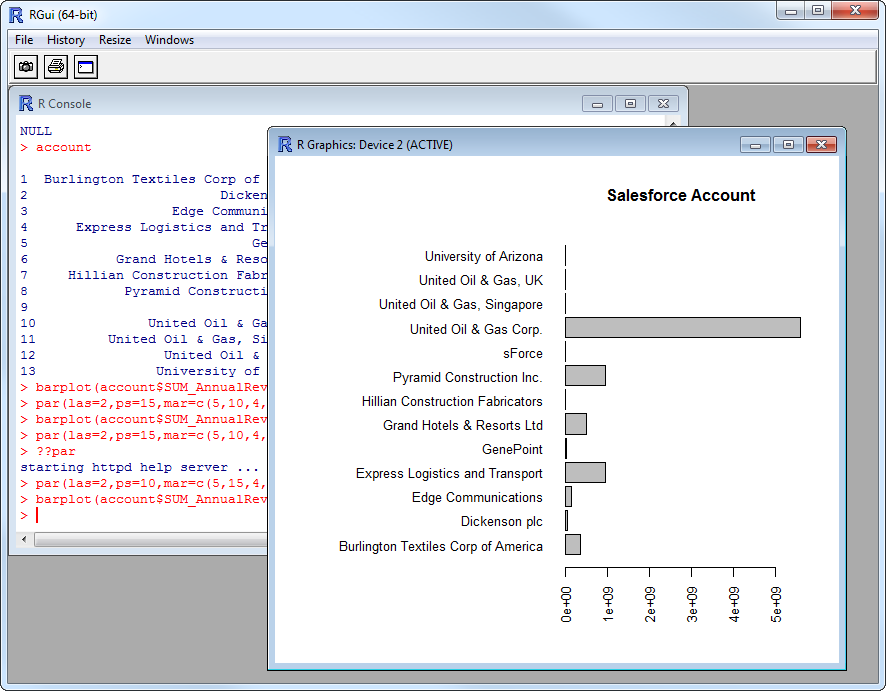Discover how a bimodal integration strategy can address the major data management challenges facing your organization today.
Get the Report →Analyze HCL Domino Data in R
Use standard R functions and the development environment of your choice to analyze HCL Domino data with the CData JDBC Driver for HCL Domino.
Access HCL Domino data with pure R script and standard SQL on any machine where R and Java can be installed. You can use the CData JDBC Driver for HCL Domino and the RJDBC package to work with remote HCL Domino data in R. By using the CData Driver, you are leveraging a driver written for industry-proven standards to access your data in the popular, open-source R language. This article shows how to use the driver to execute SQL queries to HCL Domino and visualize HCL Domino data by calling standard R functions.
Install R
You can match the driver's performance gains from multi-threading and managed code by running the multithreaded Microsoft R Open or by running open R linked with the BLAS/LAPACK libraries. This article uses Microsoft R Open 3.2.3, which is preconfigured to install packages from the Jan. 1, 2016 snapshot of the CRAN repository. This snapshot ensures reproducibility.
Load the RJDBC Package
To use the driver, download the RJDBC package. After installing the RJDBC package, the following line loads the package:
library(RJDBC)
Connect to HCL Domino as a JDBC Data Source
You will need the following information to connect to HCL Domino as a JDBC data source:
- Driver Class: Set this to cdata.jdbc.domino.DominoDriver
- Classpath: Set this to the location of the driver JAR. By default this is the lib subfolder of the installation folder.
The DBI functions, such as dbConnect and dbSendQuery, provide a unified interface for writing data access code in R. Use the following line to initialize a DBI driver that can make JDBC requests to the CData JDBC Driver for HCL Domino:
driver <- JDBC(driverClass = "cdata.jdbc.domino.DominoDriver", classPath = "MyInstallationDir\lib\cdata.jdbc.domino.jar", identifier.quote = "'")
You can now use DBI functions to connect to HCL Domino and execute SQL queries. Initialize the JDBC connection with the dbConnect function.
Prerequisites
The connector requires the Proton component to be installed. Normally, Proton is distributed as part of the AppDev pack. See the HCL documentation for instructions on acquiring and installing Proton or the AppDev pack.
Once the Proton service is installed and running, you will also need to create a user account and download its Internet certificate. This certificate can be used to set the connector certificate connection properties.
Authenticating to Domino
- Server: The name or IP address of the server running Domino with the Proton service.
- Port: The port number that the Proton service is listening on.
- Database: The name of the database file, including the .nsf extension.
- SSLClientCertType: This must match the format of the certificate file. Typically this will be either PEMKEY_FILE for .pem certificates or PFXFILE for .pfx certificates.
- SSLClientCert: The path to the certificate file.
- SSLServerCert: This can be set to (*) if you trust the server. This is usually the case, but if you want to perform SSL validation, you may provide a certificate or thumbprint instead. See the documentation for SSLServerCert for details.
Additional Server Configuration
The connector supports querying Domino views if any are defined. Before views can be queried by the connector they must be registered with the design catalog.
Please refer to the Catalog Administration section of the AppDev pack documentation for details on how to do this.
Built-in Connection String Designer
For assistance in constructing the JDBC URL, use the connection string designer built into the HCL Domino JDBC Driver. Either double-click the JAR file or execute the jar file from the command-line.
java -jar cdata.jdbc.domino.jar
Fill in the connection properties and copy the connection string to the clipboard.

Below is a sample dbConnect call, including a typical JDBC connection string:
conn <- dbConnect(driver,"jdbc:domino:Server=https://domino.corp.com;Database=names.nsf;Port=3002;SSLClientCertType=PEMKEY_FILE;SSLClientCert=full_path_of_certificate.pem;SSLServerCert=*")
Schema Discovery
The driver models HCL Domino APIs as relational tables, views, and stored procedures. Use the following line to retrieve the list of tables:
dbListTables(conn)
Execute SQL Queries
You can use the dbGetQuery function to execute any SQL query supported by the HCL Domino API:
byname <- dbGetQuery(conn,"SELECT Name, Address FROM ByName WHERE City = 'Miami'")
You can view the results in a data viewer window with the following command:
View(byname)
Plot HCL Domino Data
You can now analyze HCL Domino data with any of the data visualization packages available in the CRAN repository. You can create simple bar plots with the built-in bar plot function:
par(las=2,ps=10,mar=c(5,15,4,2))
barplot(byname$Address, main="HCL Domino ByName", names.arg = byname$Name, horiz=TRUE)







